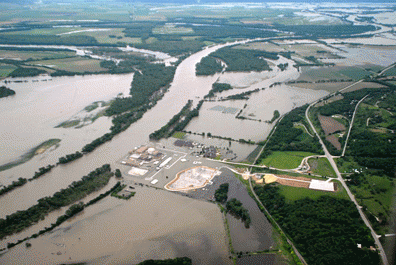WHISTLEBLOWER: NUCLEAR REGULATORS SUPPRESS FACTS, BREAK LAW

Fort Calhoun nuclear plant, June 2011
(Image by U.S. Army Corps of Engineers, Author: U.S. Army Corps of Engineer) Details Source DMCA
The likelihood was very low that an earthquake followed by a tsunami would destroy all four nuclear reactors at the Fukushima nuclear power plant, but in March 2011, that's what happened, and the accident has yet to be contained.
Similarly, the likelihood may be low that an upstream dam will fail, unleashing a flood that will turn any of 34 vulnerable nuclear plants into an American Fukushima. But knowing that unlikely events sometimes happen nevertheless, the nuclear industry continues to answer the question of how much safety is enough by seeking to suppress or minimize what the public knows about the danger.
The Nuclear Regulatory Commission (NRC) has known at least since 1996 that flooding danger from upstream dam failure was a more serious threat than the agency would publicly admit. The NRC failed from 1996 until 2011 to assess the threat even internally. In July 2011, the NRC staff completed a report finding "that external flooding due to upstream dam failure poses a larger than expected risk to plants and public safety" [emphasis added] but the NRC did not make the 41-page report public.
Instead, the agency made much of another report, issued July 12, 2011 -- "Recommendations for Enhancing Reactor Safety in the 21st Century," sub-titled "The Near-Term Task Force Review of Insights from the Fukushima Dai-Ichi Accident." Hardly four months since the continuing accident began in Japan, the premature report had little to say about reactor flooding as a result of upstream dam failure, although an NRC news release in March 2012 would try to suggest otherwise.
Censored Report May Be Crime by NRC
That 2012 news release accompanied a highly redacted version of the July 2011 report that had recommended a more formal investigation of the unexpectedly higher risks of upstream dam failure to nuclear plants and the public. In its release, the NRC said it had "started a formal evaluation of potential generic safety implications for dam failures upstream" including "the effects of upstream dam failure on independent spent fuel storage installations."
Six months later, in September 2012, The NRC's effort at bland public relations went controversial, when the report's lead author made a criminal complaint to the NRC's Inspector General, alleging "Concealment of Significant Nuclear Safety Information by the U.S. Nuclear Regulatory Commission." In a letter dated September 14 and made public the same day, Richard Perkins, an engineer in the NRC's Division of Risk Analysis, wrote Inspector General Hubert Bell, describing it as "a violation of law" that the Commission:
(Note: You can view every article as one long page if you sign up as an Advocate Member, or higher).





